DIY Pressure Washing: What You Need to Know Before Starting
Understanding Pressure Washing
Pressure washing is an effective way to clean various surfaces, from driveways and sidewalks to decks and siding. It utilizes high-pressure water streams to remove dirt, grime, mold, and other contaminants. Before starting a DIY pressure washing project, it's important to understand the basics to ensure safety and effectiveness.
Not all pressure washers are created equal. They vary in power and functionality, so choosing the right one for your needs is crucial. Consider whether you require a light-duty, medium-duty, or heavy-duty machine based on the surfaces you intend to clean.

Choosing the Right Equipment
When selecting a pressure washer, look at its PSI (pounds per square inch) and GPM (gallons per minute). Higher PSI and GPM ratings mean more power and water flow, which can be beneficial for tougher cleaning tasks. However, for delicate surfaces, a lower PSI is often safer.
In addition to the machine itself, consider the accessories you'll need. Nozzles, extension wands, and surface cleaners can make your job easier and more efficient. Make sure to read the manufacturer’s instructions carefully before use.

Safety Precautions
Safety should be your top priority when using a pressure washer. The powerful jet of water can cause injury if not handled properly. Always wear protective gear, such as safety goggles and gloves, to shield yourself from debris and water spray.
It's also essential to be mindful of your surroundings. Remove obstacles from the area you plan to clean and keep children and pets at a safe distance. If you're using chemicals or detergents, ensure they're suitable for your pressure washer and the surface you're cleaning.

Preparing the Area
Before you start pressure washing, prepare the area by clearing away loose debris and sweeping surfaces. This will help prevent damage to the surface and make your cleaning efforts more effective. Cover or move any items you don’t want to get wet or damaged.
For outdoor surfaces like decks or patios, check for any loose boards or nails that may need fixing. If you're washing the exterior of your home, close all windows and doors to prevent water from entering.
Techniques for Effective Cleaning
To achieve the best results with your pressure washer, use the correct techniques. Start by testing a small, inconspicuous area to ensure the pressure setting is appropriate. Hold the nozzle at a consistent distance from the surface to avoid streaking or damage.
Use a sweeping motion for even coverage, and work in sections to manage dirt effectively. For stubborn stains, apply a suitable detergent with a low-pressure nozzle before rinsing with a higher pressure setting.

Environmental Considerations
When pressure washing, be conscious of water usage and environmental impact. Avoid using harsh chemicals that could harm plants or wildlife. Opt for eco-friendly detergents whenever possible.
Be aware of local regulations regarding water runoff, as certain areas have laws to protect storm drains and waterways. Properly disposing of wastewater is integral to responsible pressure washing practices.
Maintenance and Storage
After completing your pressure washing project, it's important to maintain your equipment. Rinse out any detergent residues from the machine, inspect hoses for wear or damage, and store all components in a dry place.
Regular maintenance extends the life of your pressure washer and ensures it operates efficiently when needed again. Follow the manufacturer's guidelines for routine checks and servicing.

By understanding these key aspects of DIY pressure washing, you can tackle cleaning projects with confidence. Equipped with the right knowledge and tools, you'll be able to maintain your property's appearance while ensuring safety and environmental responsibility.